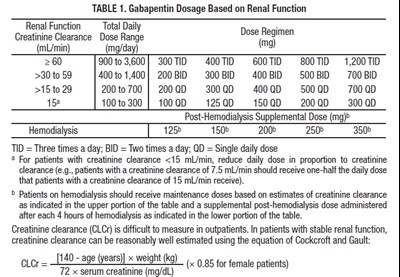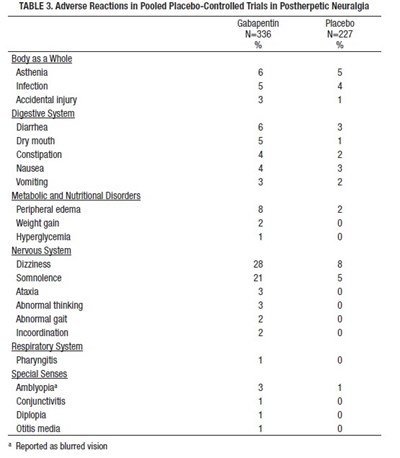Product Images Gabapentin
View Photos of Packaging, Labels & Appearance
Product Label Images
The following 13 images provide visual information about the product associated with Gabapentin NDC 53002-1472 by Rpk Pharmaceuticals, Inc., such as packaging, labeling, and the appearance of the drug itself. This resource could be helpful for medical professionals, pharmacists, and patients seeking to verify medication information and ensure they have the correct product.
image - d3fd11fe 4d3f 4002 8f9e 42cc12b4252d 01

This is a dosage table for Gabapentin based on a patient's renal function (creatinine clearance). The table provides information on the total daily dose range given for each regimen (TID, BID, and QD) based on the patient's creatinine clearance level. The table also provides supplemental post-hemodialysis doses for patients on hemodialysis. The dosage should be adjusted for patients with creatinine clearance <15 mL/min. The Cockcroft and Gault equation can be used to estimate CLCr in patients with stable renal function.*
image - d3fd11fe 4d3f 4002 8f9e 42cc12b4252d 03

This is a table presenting the risk and relative risk of antiepileptic drugs for different indications (epilepsy, psychiatric and other) in comparison to placebo patients, based on a pooled analysis. The risks are presented as events per 1000 patients, and the relative risk is calculated as the incidence of events in drug patients compared to placebo patients. The risk difference is also presented as additional drug patients with events per 1000 patients.*
image - d3fd11fe 4d3f 4002 8f9e 42cc12b4252d 04

This table shows the results of a study on adverse reactions in patients with postherpetic neuralgia who were treated with Gabapentin or Placebo. The table lists the different reactions and the percentage of patients who experienced them in each group. Some of the reactions include asthenia, infection, accidental injury, diarrhea, and abnormal thinking. Gabapentin had a higher incidence of dizziness and somnolence compared to placebo. Blurred vision was reported as a special sense reaction.*
image - d3fd11fe 4d3f 4002 8f9e 42cc12b4252d 05

This is a table summarizing the adverse reactions reported in pooled placebo-controlled add-on trials in epilepsy patients above 12 years old for Gabapentin and Placebo. The table shows the number of patients and the percentage of reported adverse reactions in each category. The adverse reactions for Gabapentin included fatigue, somnolence, dizziness, pharyngitis, and impotence, among others. The adverse reactions for Placebo included dyspepsia, dry mouth, and dental abnormalities, among others. Amblyopia was a commonly reported adverse reaction for Gabapentin patients and often described as blurred vision.*
image - d3fd11fe 4d3f 4002 8f9e 42cc12b4252d 06

This is a table showing the adverse reactions in a placebo-controlled add-on trial in pediatric epilepsy patients aged 3 to 12 years who were given Gabapentin®. The table compares the occurrence of adverse reactions for the Gabapentin® group (N=110) and the Placebo group (N=128). Adverse reactions experienced by patients in the Gabapentin® group include body weakness, fever, increased weight, fatigue, nausea and/or vomiting, somnolence, hostility, emotional labile, dizziness, hyperkinesia, Bronchitis, and respiratory infection. The placebo group experienced a lower rate of adverse reactions in general.*
image - d3fd11fe 4d3f 4002 8f9e 42cc12b4252d 08

This text provides a table with information on controlled PHN studies, including the duration, dosages, and number of patients in each study. The table includes two studies, with varying target doses of Gabapentin given in three divided doses (TID). The total number of patients involved in the studies was 336 for Gabapentin and 227 for Placebo.*
image - d3fd11fe 4d3f 4002 8f9e 42cc12b4252d 11

The text presents a figure that shows the percentage of patients with more than a 50% reduction in pain score in controlled PHN studies. The figure includes two studies, but the information is not clear enough to determine the overall outcomes of the studies. The text also presents some numbers, possibly dosages or cost of the medication used in the studies.*
* The product label images have been analyzed using a combination of traditional computing and machine learning techniques. It should be noted that the descriptions provided may not be entirely accurate as they are experimental in nature. Use the information in this page at your own discretion and risk.





